Publication Information
Frequency: Continuous
Format: PDF and HTML
Versions: Online (Open Access)
Year first Published: 2019
Language: English
| Journal Menu |
| Editorial Board |
| Reviewer Board |
| Articles |
| Open Access |
| Special Issue Proposals |
| Guidelines for Authors |
| Guidelines for Editors |
| Guidelines for Reviewers |
| Membership |
| Fee and Guidelines |
 |
Prototype of Non-Genetically Modified Soybean Tracking System Using Blockchain Technology
Inácio Henrique Yano*
Embrapa Informática Agropecuária, Empresa Brasileira de Pesquisa Agropecuária (Embrapa), Campinas/SP, Brazil
Received Date: December 10, 2019; Accepted Date: December 21, 2019; Published Date: December 30, 2019
*Corresponding author: Inácio Henrique Yano, Embrapa Informática Agropecuária, Empresa Brasileira de Pesquisa Agropecuária (Embrapa), Campinas/SP, Brazil. Tel: +551932115768; Email: inacio.yano@embrapa.br
Citation: Yano IH (2019) Prototype of Non-Genetically Modified Soybean Tracking System Using Blockchain Technology. Adv Agri Harti and Ento: AAHE-107
Abstract
Genetically Modified Organisms (GMO) soybean is a soybean whose genetic material has been modified using genetic engineering techniques. GMO defenders say that this technology reduces the cost of food and helps producers deal with pests and diseases more safely. On the opposite consumers and environmental groups argue that transgenic crops drive higher use of pesticides. Because of this, there is a specific market for non-GMO crops. Some companies that export to Asia and Europe markets pay a premium for non-GMO soybean. But this non-GMO soybean must have a certificate indicating their purity, i.e., which there is not a mix with GMO soybean. The aim of this work is the development of a prototype of a system to track non-GMO soybean to guarantee its purity. The prototype developed in this work used blockchain technology. The choice for blockchain was because it is very secure against tampering, and, also is a distributed system proper for applications like this, which will track the non-GMO soybean from cultivation to product delivery.
Keywords: Ethereum; Non-GMO; Smart contract
Introduction
Crops such as corn, soybeans, and cotton are genetically engineered to resist disease, tolerate drought and resist spraying pesticides like glyphosate - the active ingredient in Monsanto's Roundup herbicide. GMO advocates say the technology reduces the cost of food and helps producers deal with pests and diseases more safely. But some consumers and environmental groups argue that transgenic crops drive pesticide use rather than reducing agrochemical applications. These entities also say that GMOs pose threats to the environment and there are doubts about the impact of genetically modified foods on human health. Because of this emerged a demand for conventional raw material food. To meet this demand, producers in Mato Grosso and Embrapa Brazilian Agricultural Research Corporation create a program to promote the use of conventional seeds [1, 2].
As a result, a move to replace transgenic soybeans with conventional seeds is gaining momentum in Mato Grosso, Brazil's largest producing state. This focus on conventional soybean planting (also known as free or non-GMO soybeans) occurs to serve the export niche of non-GMO products, which are most valued. To get an idea of the potential of this market, Europe has an annual demand of 2.7 million tons and China 5 million tons. Access to these markets, financing programs, reduced costs due to greater control over inputs, and the possibility of receiving bonuses from the sale of certified material are the main economic advantages for producers [3, 4].
Companies such as Amaggi, Imcopa International and Caramuru Alimentos pay a premium award for conventional soy to serve Asian and European markets. The average producer premium per bag is 40% compared to transgenic soybeans, according to the Free Soy Institute, an entity created to encourage the development of the conventional soybean market, profitability and safety [5-7].
For the reintroduction of conventional soybeans, some challenges must be overcome, such as the obligation to isolate the crop, to avert mix with transgenic soybeans during cultivation, strict controls to avoid contamination in transport and shipping to ports and the low availability of improved non-GMO seeds [8].
A system that tracks non-GMO soybeans - and used for tracing samples and information from planting, passing through controls on cultivation, harvesting, and transportation to market delivery - can be of great value in reducing costs, ensuring soybean purity, and obtaining certifications easily.
This work proposes the use of blockchain technology to build a prototype of the Non-GMO Soybean Tracking System because it is a distributed system, facilitating the registration of inspections and sample data, which will occur at different locations and at different times as long production of soybean. In addition to being a very safe system against tampering, generating reliability for auditors and consumers.
Material and Methods
The prototype developed in this work is divided into five main procedures, as shown in (Figure 1). Except for the first procedure (Data Definition), the other four procedures are control procedures (Seed Control, Field Inspection, Receiving Control, and Shipping Supervision). These four control procedures are responsible for the purity of non-GMO soybeans from cultivation to product delivery.
The Data Definition procedure is part of the smart contract and defines variables to be stored in a blockchain infrastructure. The smart contract is a computer program, whose code developed at Remix Development Environment (IDE Remix) [9], using Solidity 0.4.2 language - which is very similar to C++, Python, and other programming languages - specific for Ethereum Blockchain Networks [10, 11].
(Figure 2) shows on the right side, the “Compile” tab of the IDE Remix for smart contract compilation. (Figure 2) also shows on its left side the smart contract code. The first line of the presented smart code is the compiler version, in the third line, the name of the smart contract (SoyTracking.sol) and the following lines are the data variables to be stored in the smart contract and blockchain system transactions. The data effectively recorded in the smart contract is in a struct (Figure 3), which is a grouping of data. The use of a struct facilitates to query the stored data, using a key. In this prototype, the key is the lot number, which allows accessing all data in a single query, using the mapping command. This command associates the SoyInf struct and the lot number. In this prototype, the SoyInf struct contains the address of the system operator (sender) - a person responsible for recording the data -, the lot number and the data from the four non-GMO soybean control procedures.
The second procedure is the control of seeds to ensure non-GMO soybean production. This step seeks to identify the presence of transgenic soybean variety to avoid contamination of production fields. The tasks of this step are sampling according to ISO standards, evidence stored for 90 days, transgenic analysis by PCR (Polymerase Chain Reaction) method, and the record of all operations [12].
The third procedure is field inspection to ensure that no varieties of transgenic soybeans are being cultivated by producers to avoid contamination. The tasks of this step are sampling during the growing season, leaf test with SDI Trait, and visits with the cooperative technician and auditor [12].

Figure 1: WBS of the Non-GMO Soybean Tracking System.

Figure 2: Remix development environment [12].
The fourth procedure is the receipt at the processing and storage units, aimed at ensuring that no vehicles containing transgenic soybean unload at the receiving units, thus avoiding contamination and ensuring the integrity of the non-GMO soybean. The tasks of this step are sampling all vehicles, evidence stored for 90 days, every 5,000 tons performs a PCR test for segregation guarantee and registration and reporting of all vehicles [12].
The last procedure of the traceability system is shipment supervision. The purpose of this procedure is to ensure that no contamination can occur in the vehicles during the shipment and product delivery. This stage includes a visual inspection of all vehicles, inspection records, and monthly record audits. Throughout the procedure, the certifier acts by ensuring that all phases have been completed and audited. In the end, the certifier issues a certificate of product traceability with international validity [12].
For setting values to variables and record data into the blockchain, each variable and each procedure in the Non-GMO Soybean Tracking System has a correspondent function in the smart contract. (Figure 4) is an example of a function to set the lot number. The lot number is a unique identifier of an amount of soybean used for accountability, sampling identifier, and qualification. The IDE Remix provides a button with a red background color for each function as an interface for simulation and tests of the smart contract (Figure 5) and, also provides a blue background color button for query the values of the variables (Figure 6).
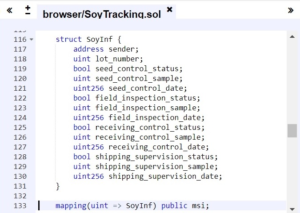
Figure 3: SoyInfstruct and mapping.

Figure 4: Function for lot number setment.

Figure 5: Red back grounded button provided by IDE Remix for the function to set lot number.

Figure 6: Blue back grounded button provided by IDE Remix to query the lot number.
To execute a procedure is necessary to set all the variables values first. (Figure 7) shows the code of the Seed Control procedure. The execution of this procedure stores the sender address - which is the current account responsible for the transaction in the blockchain infrastructure -, the lot number, and the seed control status - which informs if the lot is free of GMO soybean or not-, the seed control sample - to record the number of the sample - and the sample taken date. The producer or the trading company will keep the samples for at least 90 days for audit purposes.
(Figure 7) also shows the LogSeedControl declaration using the command event. The Seed Control procedure stores data in the smart contract address and using the function LogSeedControl logs the same data in the blockchain transaction. (Figure 10) shows the result of the execution of the Seed Control procedure, with LogSeedControl data highlighted in red.
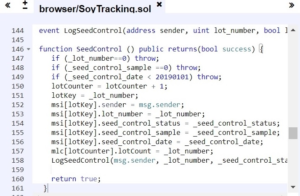
Figure 7: LogSeedControl event and Seed Control function to store seed control data into blockchain transaction and smart contract respectively.
Results
The interface to execute the smart contract is the “Run” tab of the IDE Remix, shown in (Figure 8). After deployed, the smart contract receives an address to store data and is ready for simulations and tests. The IDE Remix provides five accounts for tests - each one starts with a balance of 100 ether for accounting purposes [13].

Figure 8: IDE Remix's “Run” tab.
After setting the lot number (Figure 5), to execute the Seed Control procedure is necessary to set the values of seed control status and date and number of the sample. All these values will be stored in the smart contract by clicking in the SeedControl button (Figure 9) and, also in the blockchain transaction by the LogSeedControl function, declared in the event command. (Figure 10) shows an example of Seed Control function execution with logged data highlighted.
Similarly of recording Seed Control data, data about Field Inspection, Receiving Control and Shipping Supervision procedures will be recorded as these processes have been completed (Figure 11).

Figure 9: Interface (buttons) provided by IDE Remix, to set values of seed control status, seed control sample and seed control date and execution of SeedControl procedure.
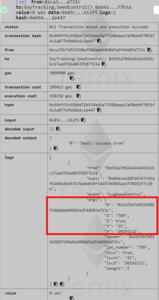 Figure 10: Result of the execution of the Seed Control procedure, with LogSeedControl data highlighted in red.
Figure 10: Result of the execution of the Seed Control procedure, with LogSeedControl data highlighted in red.

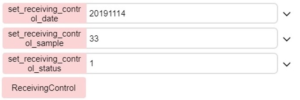

Figure 11: IDE Remix's “Run” tab.
The lot number is the key to query all recorded data in the smart contract. For this purpose, the msi mapping associates the lot number with the SoyInf struct. The IDE Remix also provides a query button for mapping declarations. (Figure 12) shows the result of querying lot 789 data after completed all procedures of soybean tracking.
Conclusion
This work presented a prototype of a non-GMO soybean tracking system. Since it is a prototype, it contains only four checking points for audit, but demonstrate the potential of blockchain technology, for this kind of Decentralized Application (DApp), providing security and distributed databases. Since this application is based on sampling analysis, the interface given by IDE Remix was functional. But in future work, new technological features will be studied, such as the use of RFID to track vehicles and communication interfaces between sample analysis record systems and the blockchain database.
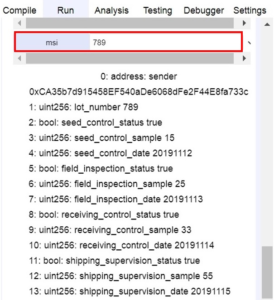
Figure 12: Result of querying lot number 789 using msi mapping.
References
- BREHM, Daniel Otto (2007) Análise Custo-benefício de um sistema de rastreabilidade e certificaçăo para a soja năo geneticamente modificada: o caso da Cooperativa AgráriaMista de Entre Rios.
- PELAEZ V, ALBERGONI L, GUERRA M, (2004) Soja Transgênica versus soja convencional: uma análise comparativa de custos e benefícios. Cadernos de Ciência&Tecnologia 21: 279-309.
- BROGIN R, NUNES M, da SILVA E V, LEMOS B, RAMOS JUNIOR EU, et al, (2019) Avaliação de cultivares de soja não-GM em unidades demonstrativas no estado de Mato Grosso, na safra 2017/18. In Embrapa Soja-Artigos Anais de congresso (ALICE). In: REUNIÃO DE PESQUISA DE SOJA, 37. 2019, Londrina. Resumos Expandidos. Londrina: Embrapa Soja, 2019. (Embrapa Soja. Documentos, 413).
- SILVA WM, BROGIN RL, Soja convencional versus transgênica: custo de produção e estimativas de receitas para o Estado de Mato Grosso. In: Embrapa Soja-Artigo em anais de congresso (ALICE). In: REUNIÃO DE PESQUISA DE SOJA, 36. 2017, Londrina, PR. Resumos expandidos... Londrina: Embrapa Soja, 2017. p. 286-289. (Embrapa Soja. Documentos, 388). Editado por Alvadi Antonio Balbinot Junior, Fernando Augusto Henning, Regina Maria Villas Bôas de Campos Leite., 2017.
- DA SILVA EV, et al. (2019) Custos de produção de soja convencional e transgênica: oportunidades de negócios com o cultivo de soja convencional no estado de Mato Grosso. In: Embrapa Soja-Artigo em anais de congresso (ALICE). In: REUNIÃO DE PESQUISA DE SOJA, 37. 2019, Londrina. Resumos expandidos... Londrina: Embrapa Soja, 2019. (Embrapa Soja. Documentos, 413). 2019.
- TORRES, Heloisa Helena de Faria A (2017) busca pela sustentabilidade na produção de soja brasileira: um estudo sobre a certificação RTRS (Round Table On Responsible Soy) aplicada empresa AMAGGI.
- SCHLESINGER, Sergio A (2004) soja no Brasil. Programa Brasil Sustentável. São Paulo.
- MYSZCZUK AP, WANDSCHEER CB, GLITZ F (2010) Segurança Alimentar e Consumo: Rastreabilidade e Certificação de Grãos GM e NON-GM. Revista Cesumar–Ciências Humanas e Sociais Aplicadas 15: 2010.
- REMIX ETHEREUM IDE. EUA (2019) Available at: https://remix.ethereum.org/ Access on: 21 nov. 2019.
- Página institucional. EUA (2019) Available at: https://www.ethereum.org. Access on: 30 set. 2019.
- SILVA, FGC et al. (2019) Avaliação da técnica de blockchain na rastreabilidade na agroindústria a sucroenergética. In: Embrapa Informática Agropecuária-Artigo Em Anais de congresso (ALICE). In: ENCONTRO NACIONAL DE ENGENHARIA DE PRODUÇÃO, 39. 2019, Santos. Os desafios da engenharia de produção para uma gestão inovadora da Logística e Operações: anais. Rio de Janeiro: ABEPRO, 2019. 2019.
- AQUINO, DAYANI CRIS et al. (2017) AnáliseCusto/Benefício do Sistema de Rastreabilidade e Certificação da Soja Não-Gm da Imcopa. In: XLV Congresso da Sociedade Brasileira de Economia, Administração e Sociologia Rural. Anais XLV Congresso da Sociedade Brasileira de Economia, Administração e Sociologia Rural. Sober: Londrina/PR. 2007.
- YANO IH, SANTOS, EH, CASTRO, A. de, BERGIER I, SANTOS PM, et al. (2018) Modelo de rastreamento bovino via Smart Contracts com tecnologia Blockchain. Embrapa Informática Agropecuária-Comunicado Técnico (INFOTECA-E).